Compensating Acquisition Footprint for Amplitude-Preserving Angle Domain Common Image Gathers Based on 3D Reverse Time Migration
Abstract
:1. Introduction
2. Materials and Methods
2.1. Concept of Amplitude-Preserving ADCIG
2.2. Theory of Amplitude-Preserving ADCIG
2.3. Method for Computing the Subsurface Incident Angle and Azimuth
2.4. Angle Domain Illumination Compensation Factor for Constant Medium
2.5. Angle Domain Illumination Compensation Factor for v(z) Medium
3. Results
3.1. Synthetic Example
3.2. Field Data Example
4. Discussion
5. Conclusions
Author Contributions
Funding
Data Availability Statement
Conflicts of Interest
References
- Liu, H.; Li, B.; Tong, X.; Liu, Q. The algorithm of high order finite difference pre-stack reverse time migration and GPU implementation. Chin. J. Geophys. 2010, 53, 1725–1733. [Google Scholar] [CrossRef]
- Liu, H.; Li, B.; Liu, H.; Tong, X.; Liu, Q.; Wang, X.; Liu, W. The issues of pre-stack reverse time migration and solutions with GPU implementation. Geophys. Prospect. 2012, 60, 906–918. [Google Scholar] [CrossRef]
- Liu, H.; Liu, H.; Tong, X.; Liu, Q. A Fourier integral algorithm and its GPU/CPU collaborative implementation for one-way wave equation migration. Comput. Geosci. 2012, 45, 139–148. [Google Scholar] [CrossRef]
- Liu, H.; Zhang, H. reducing computation cost by Lax-Wendroff methods with fourth-order temporal accuracy. Geophysics 2019, 84, T109–T119. [Google Scholar] [CrossRef]
- Zhang, Y.; Sun, J. Practical issues of reverse time migration: True-amplitude gathers, noise removal and harmonic-source encoding. First Break 2009, 26, 19–25. [Google Scholar] [CrossRef]
- Shan, G.; Biondi, B. Angle-domain common-image gathers for steep reflectors. In Proceedings of the 78th Annual International Meeting, SEG, Expanded Abstracts, Las Vegas, NV, USA, 9–14 November 2008; pp. 3068–3072. [Google Scholar] [CrossRef]
- Bleistein, N.; Cohen, J.K.; Stockwell, J.W. Mathematics of Multidimensional Seismic Inversion; Springer: Berlin/Heidelberg, Germany, 2001. [Google Scholar]
- Xu, S.; Chauris, H.; Lambaré, G.; Noble, M. Common angle migration: A strategy for imaging complex media. Geophysics 2001, 66, 1877–1894. [Google Scholar] [CrossRef]
- Zhang, Y.; Zhang, G.; Bleistein, N. Theory of true-amplitude one-way wave equations and true-amplitude common-shot migration. Geophysics 2005, 70, E1–E10. [Google Scholar] [CrossRef]
- Zhang, Y.; Xu, S.; Bleistein, N.; Zhang, G. True-amplitude, angle-domain, common-image gathers from one-way wave-equation migrations. Geophysics 2007, 72, S49–S58. [Google Scholar] [CrossRef]
- Biondi, B.; Symes, W.W. Angle-domain common-image gathers for migration velocity analysis by wavefield-continuation imaging. Geophysics 2004, 69, 1283–1298. [Google Scholar] [CrossRef]
- Jin, H.; McMechan, G.A.; Guan, H. Comparison of methods for extracting ADCIGs from RTM. Geophysics 2014, 79, S89–S103. [Google Scholar] [CrossRef]
- Xu, S.; Zhang, Y.; Tang, B. 3D angle gathers from reverse time migration. Geophysics 2011, 76, S77–S92. [Google Scholar] [CrossRef]
- Liu, H.; Luo, Y. Invertible radon transform for making true amplitude angle gathers. In Proceedings of the SEG Technical Program Expanded Abstracts, New Orleans, LA, USA, 18–23 October 2015; pp. 4158–4163. [Google Scholar] [CrossRef]
- Zhang, Y.; Xu, S.; Tang, B.; Bai, B.; Huang, Y.; Huang, T. Angle gathers from reverse time migration. Lead. Edge 2010, 29, 1364–1371. [Google Scholar] [CrossRef]
- Luo, M.; Lu, R.; Winbow, G.; Bear, L. A comparison of methods for obtaining local image gathers in depth migration. In Proceedings of the 80th Annual International Meeting, SEG, Expanded Abstracts, Denver, CO, USA, 17–22 October 2010; pp. 3247–3251. [Google Scholar] [CrossRef]
- Sava, P.; Fomel, S. Angle-gathers by Fourier transform. Stanf. Explor. Proj. Rep. 2000, 103, 119–130. [Google Scholar]
- Sava, P.; Fomel, S. Angle-domain common-image gathers by wavefield continuation methods. Geophysics 2003, 68, 1065–1074. [Google Scholar] [CrossRef]
- Sava, P.; Fomel, S. Time-shift imaging condition in seismic migration. Geophysics 2006, 71, S209–S217. [Google Scholar] [CrossRef]
- Xie, X.; Wu, R.S. Extracting angle domain information from migrated wavefields. In Proceedings of the 72nd Annual International Meeting, SEG, Expanded Abstracts, Salt Lake City, UT, USA, 29 September–2 October 2002; pp. 1360–1363. [Google Scholar] [CrossRef]
- Yan, R.; Xie, X. A new angle-domain imaging condition for reverse time migration. In Proceedings of the 79th Annual International Meeting, SEG, Expanded Abstracts, Houston, TX, USA, 25–30 October 2009; pp. 2784–2788. [Google Scholar] [CrossRef]
- Yan, R.; Xie, X. An angle-domain imaging condition for elastic reverse time migration and its application to angle gather extraction. Geophysics 2012, 77, S105–S115. [Google Scholar] [CrossRef]
- Yoon, K.; Guo, M.; Cai, J.; Wang, B. 3D RTM angle gathers from source wave propagation direction and dip of reflector. In Proceedings of the 81st Annual International Meeting, SEG, Expanded Abstracts, San Antonio, TX, USA, 18–23 September 2011; pp. 1057–1060. [Google Scholar] [CrossRef]
- Tang, C.; McMechan, G.A. Multi directional-vector-based elastic reverse time migration and angle-domain common-image gathers with approximate wavefield decomposition of P-and S-waves. Geophysics 2017, 83, S57–S79. [Google Scholar] [CrossRef]
- Schuster, G.T. Least-squares cross-well migration. In Proceedings of the 63rd Annual International Meeting, SEG, Expanded Abstracts, Washington, DC, USA, 26–30 September 1993; pp. 110–113. [Google Scholar] [CrossRef]
- Luo, Y.; Wang, Y.; AlBinHassan, N.; Alfaraj, M. Computation of dips and azimuths with weighted structural tensor approach. Geophysics 2006, 71, V119–S121. [Google Scholar] [CrossRef]
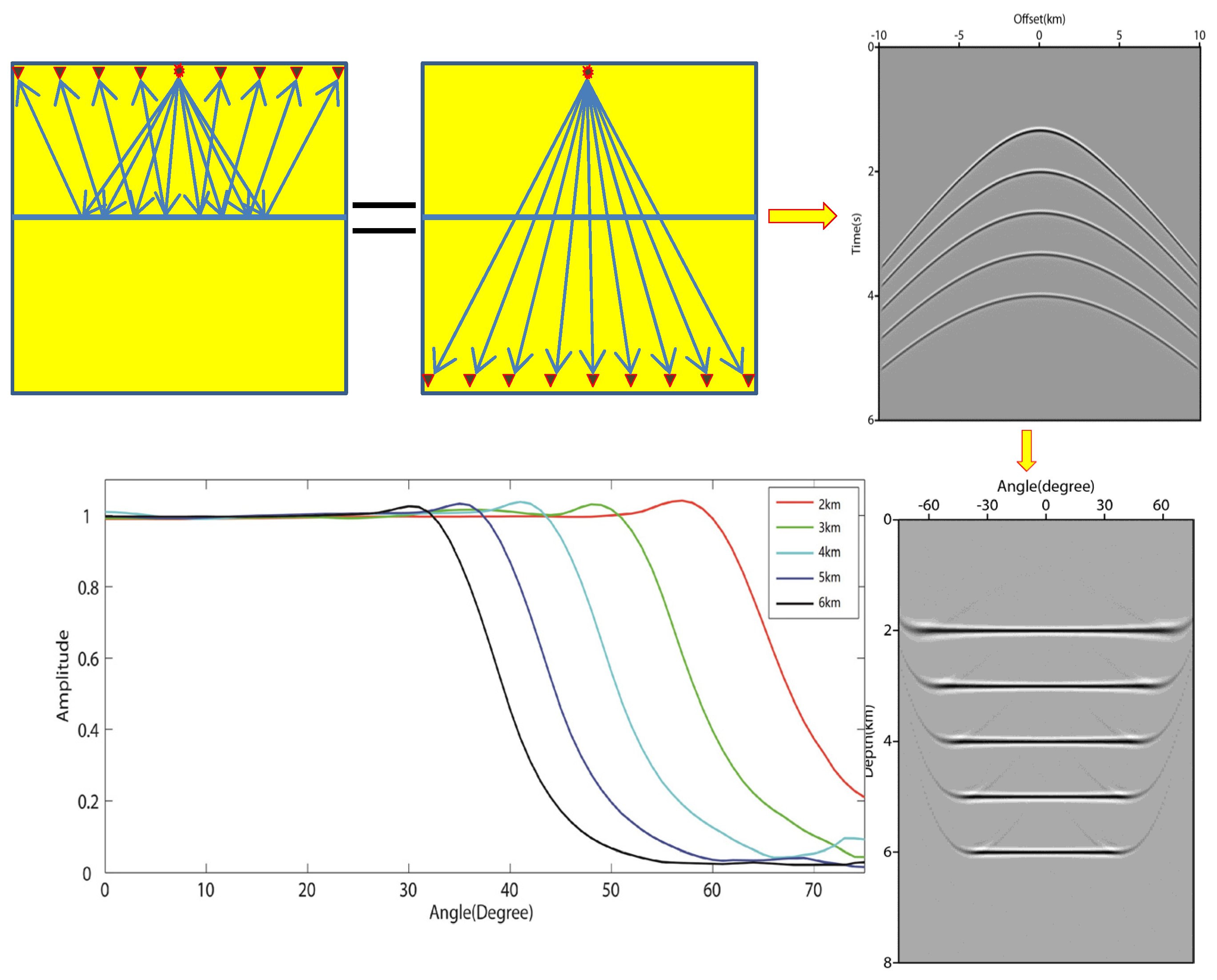
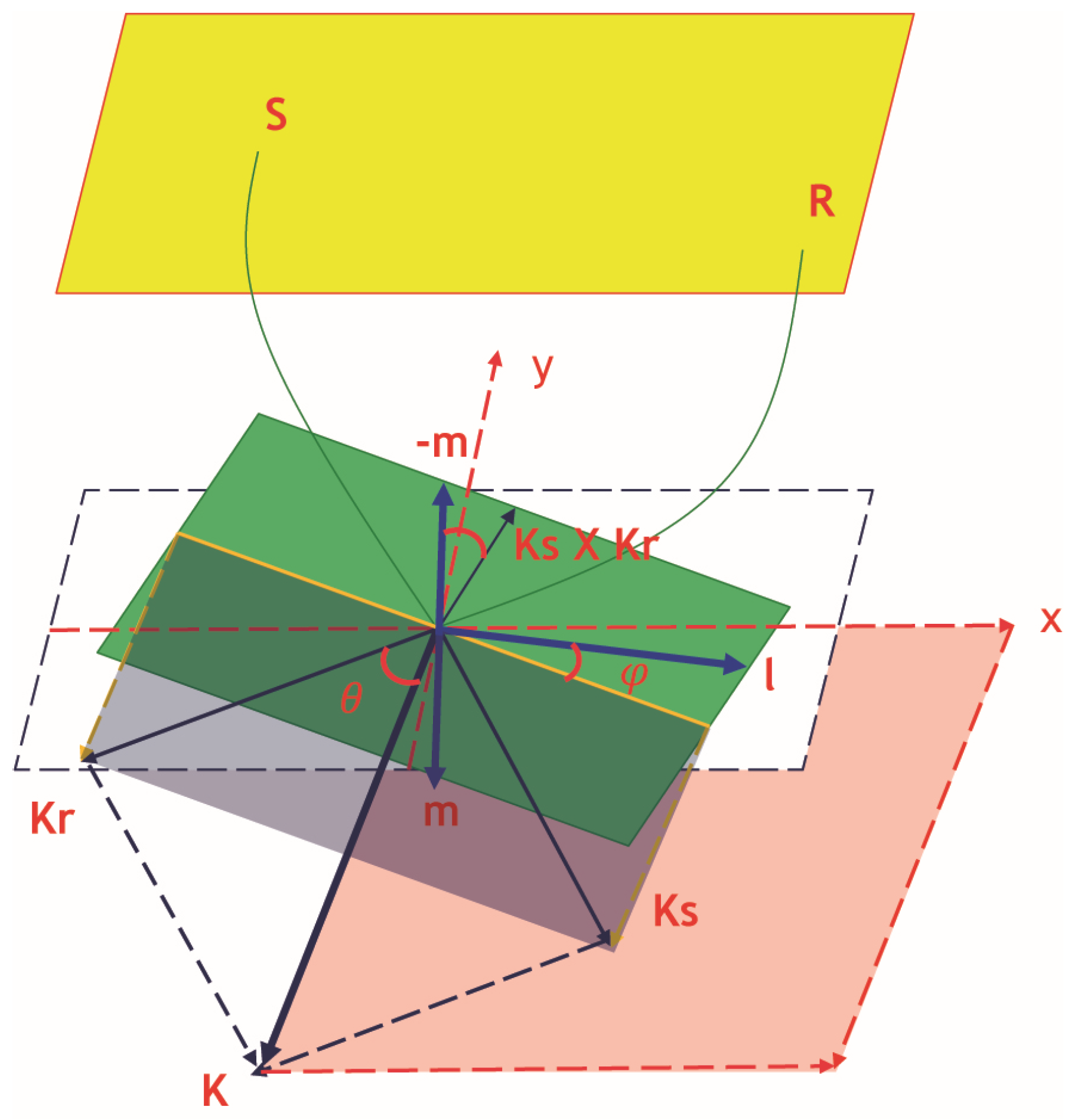




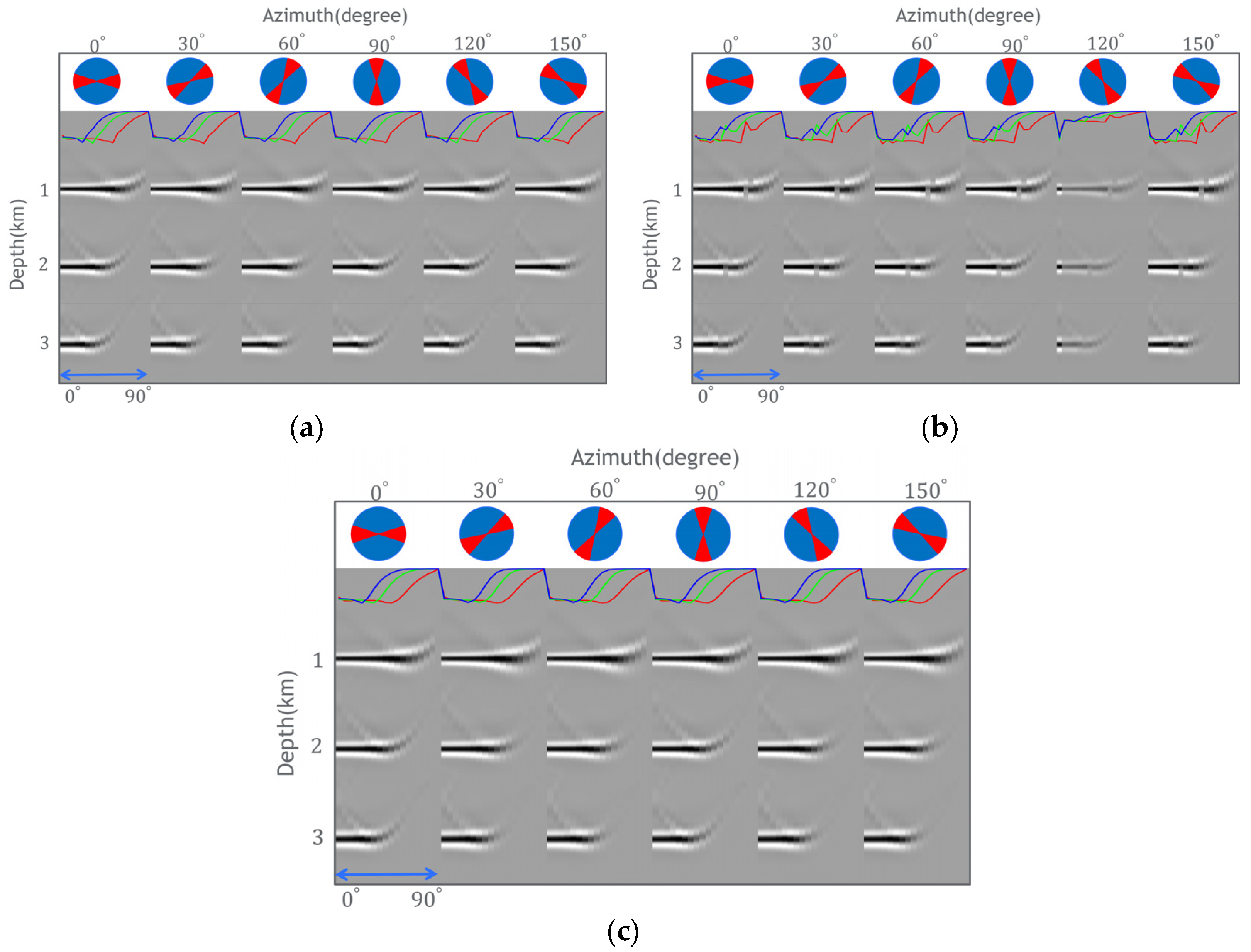
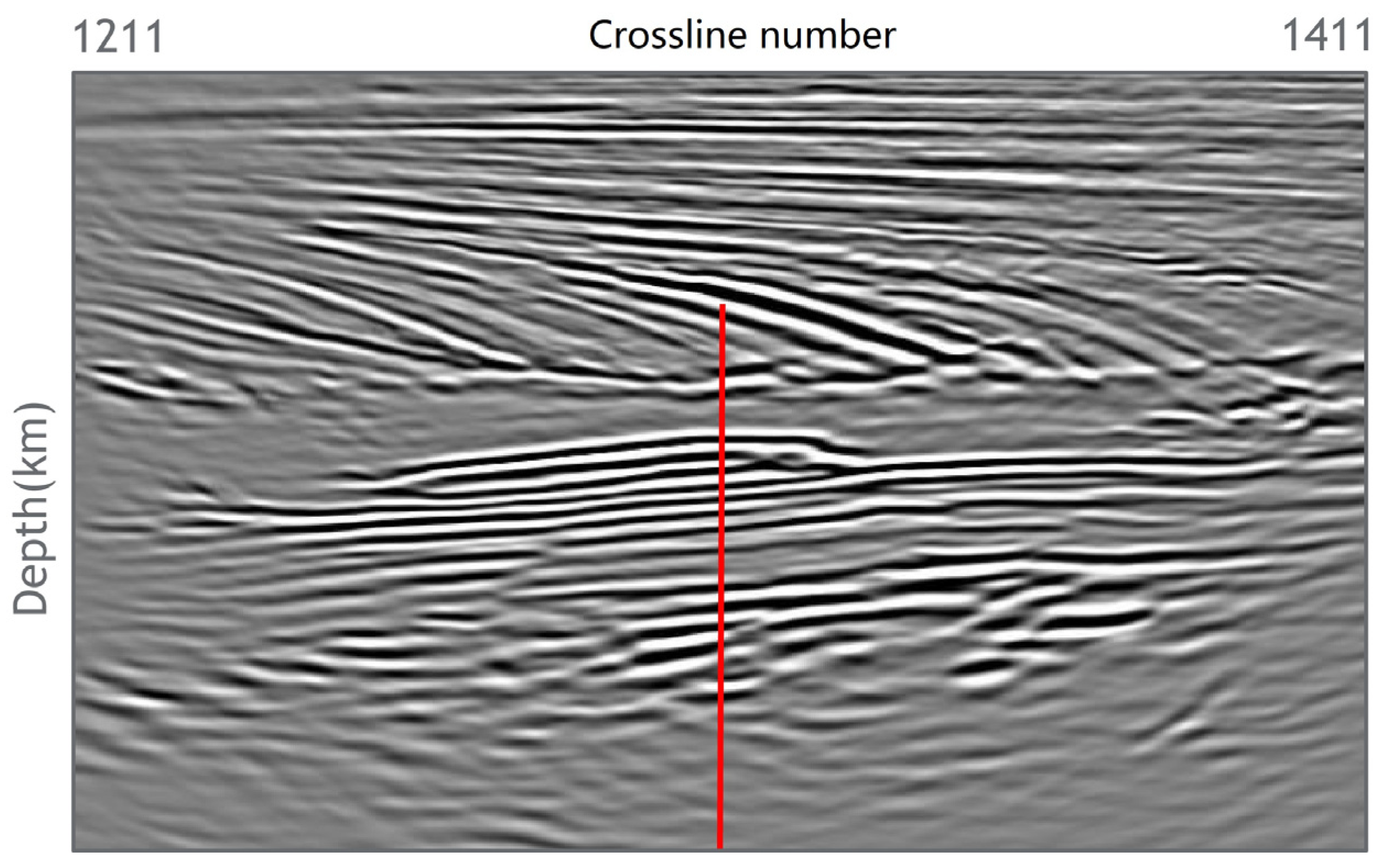

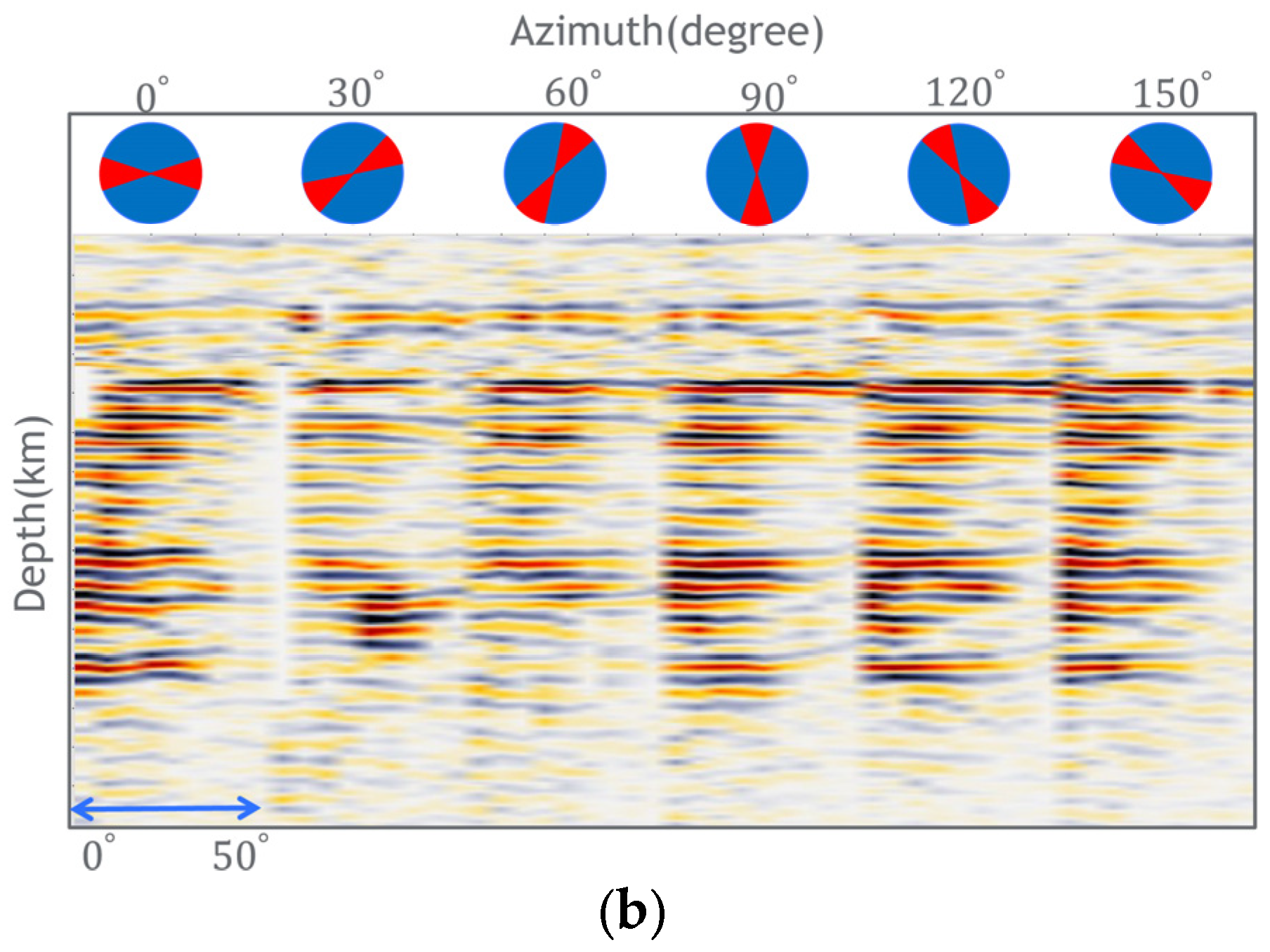
Disclaimer/Publisher’s Note: The statements, opinions and data contained in all publications are solely those of the individual author(s) and contributor(s) and not of MDPI and/or the editor(s). MDPI and/or the editor(s) disclaim responsibility for any injury to people or property resulting from any ideas, methods, instructions or products referred to in the content. |
© 2024 by the authors. Licensee MDPI, Basel, Switzerland. This article is an open access article distributed under the terms and conditions of the Creative Commons Attribution (CC BY) license (https://creativecommons.org/licenses/by/4.0/).
Share and Cite
Liu, H.; Fu, L.; Li, Q.; Liu, L. Compensating Acquisition Footprint for Amplitude-Preserving Angle Domain Common Image Gathers Based on 3D Reverse Time Migration. Remote Sens. 2024, 16, 3362. https://doi.org/10.3390/rs16183362
Liu H, Fu L, Li Q, Liu L. Compensating Acquisition Footprint for Amplitude-Preserving Angle Domain Common Image Gathers Based on 3D Reverse Time Migration. Remote Sensing. 2024; 16(18):3362. https://doi.org/10.3390/rs16183362
Chicago/Turabian StyleLiu, Hongwei, Liyun Fu, Qingqing Li, and Lu Liu. 2024. "Compensating Acquisition Footprint for Amplitude-Preserving Angle Domain Common Image Gathers Based on 3D Reverse Time Migration" Remote Sensing 16, no. 18: 3362. https://doi.org/10.3390/rs16183362




